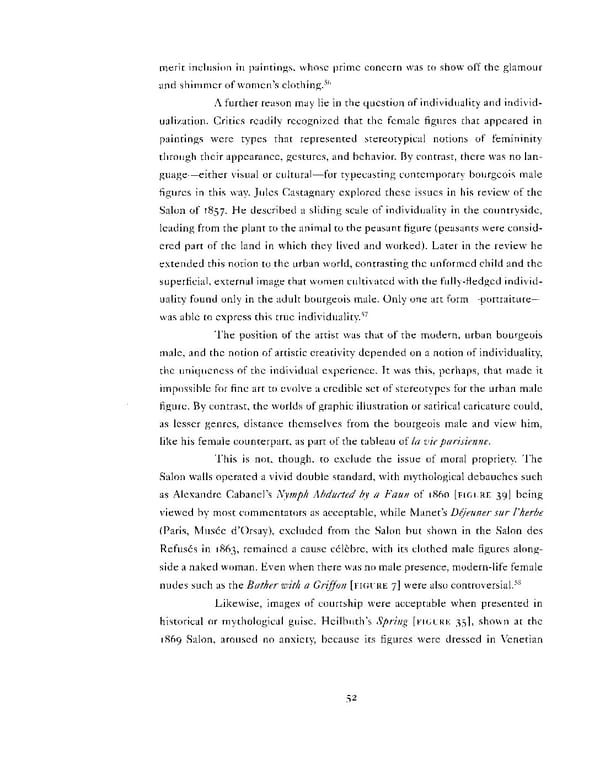merit inclusion in paintings, whose prime concern was to show off the glamour 56 and shimmer of women's clothing. A further reason may lie in the question of individuality and individ- ualization. Critics readily recognized that the female figures that appeared in paintings were types that represented stereotypical notions of femininity through their appearance, gestures, and behavior. By contrast, there was no lan- guage—either visual or cultural—for typecasting contemporary bourgeois male figures in this way. Jules Castagnary explored these issues in his review of the Salon of 1857. He described a sliding scale of individuality in the countryside, leading from the plant to the animal to the peasant figure (peasants were consid- ered part of the land in which they lived and worked). Later in the review he extended this notion to the urban world, contrasting the unformed child and the superficial, external image that women cultivated with the fully-fledged individ- uality found only in the adult bourgeois male. Only one art form—portraiture— 57 was able to express this true individuality. The position of the artist was that of the modern, urban bourgeois male, and the notion of artistic creativity depended on a notion of individuality, the uniqueness of the individual experience. It was this, perhaps, that made it impossible for fine art to evolve a credible set of stereotypes for the urban male figure. By contrast, the worlds of graphic illustration or satirical caricature could, as lesser genres, distance themselves from the bourgeois male and view him, like his female counterpart, as part of the tableau of la vie parisienne. This is not, though, to exclude the issue of moral propriety. The Salon walls operated a vivid double standard, with mythological debauches such as Alexandre Gabanel's Nymph Abducted by a Faun of 1860 [FIGURE 39] being viewed by most commentators as acceptable, while Manet's Dejeuner sur I'herbe (Paris, Musee d'Orsay), excluded from the Salon but shown in the Salon des Refuses in 1863, remained a cause celebre, with its clothed male figures along- side a naked woman. Even when there was no male presence, modern-life female nudes such as the Bather with a Griffon [FIGURE 7] were also controversial.58 Likewise, images of courtship were acceptable when presented in historical or mythological guise. Heilbuth's Spring [FIGURE 35], shown at the 1869 Salon, aroused no anxiety, because its figures were dressed in Venetian 52
 Pierre-Auguste Renoir: La Promenade Page 59 Page 61
Pierre-Auguste Renoir: La Promenade Page 59 Page 61